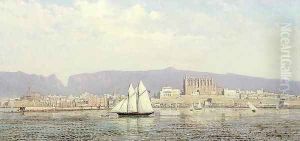Ricardo Ankermann y Riera Paintings
Ricardo Ankermann y Riera, a Spanish painter born in 1862 and deceased in 1907, was a notable figure in the art world during the late 19th and early 20th centuries. Ankermann, born in Palma de Mallorca, Spain, was part of a vibrant period in Spanish art, characterized by a transition from traditional to modernist approaches. His early life in the Balearic Islands, with its rich cultural and natural landscapes, profoundly influenced his artistic direction, imbuing his works with a distinct sense of place and emotion.
Ankermann pursued his artistic education at the esteemed Academy of San Fernando in Madrid, where he was exposed to and influenced by the prevailing artistic movements of the time, including Romanticism and Realism. His education and talent enabled him to develop a refined technique, characterized by meticulous attention to detail and a masterful use of color and light. Throughout his career, Ankermann was known for his landscapes and genre paintings, often depicting scenes of everyday life in Spain with a romantic sensibility.
Despite his relatively short life, Ankermann's work left a significant mark on Spanish art. He participated in numerous exhibitions, achieving recognition and awards that cemented his reputation. His paintings are celebrated for their ability to capture the essence of Spanish culture and the beauty of its landscapes, serving as a bridge between the traditional past and the modernist future of Spanish painting.
After his death in 1907, Ricardo Ankermann y Riera's legacy continued to influence Spanish art. Today, his works are held in high regard, featured in collections and museums across Spain and internationally. His contribution to the development of modern Spanish art is recognized as a pivotal link in the evolution of the country's artistic heritage, making him a cherished figure among art historians and enthusiasts alike.
